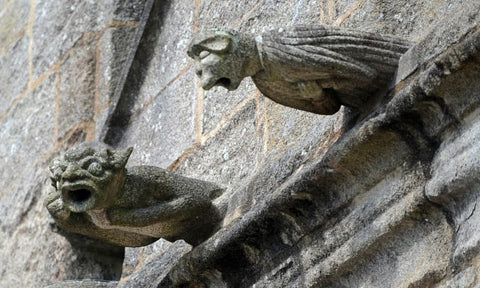
But gargoyles, it turns out, are full of surprises. Read on to learn the origin of their name, their very functional purpose, and what makes a gargoyle different from a grotesque.
THERE IS A DARTH VADER GARGOYLE AT WASHINGTON NATIONAL CATHEDRAL IN WASHINGTON D.C.

GARGOYLES SERVE A PRACTICAL PURPOSE

When gargoyles began appearing on churches throughout Europe in the 13th century, they served as decorative water spouts, engineered to preserve stone walls by diverting the flow of rainwater outward from rooftops. This function, technically speaking, distinguishes gargoyles from other stone beasts like grotesques and bosses, although these days the term encompasses all sorts of decorative creature carvings.
THE NAME COMES FROM A DRAGON-SLAYING LEGEND

The word gargoyle derives from the French gargouille, meaning "throat." This would appear to take its inspiration from the statues' water-siphoning gullets, but in fact the name comes from the French legend of "La Gargouille," a fearsome dragon that terrorized the inhabitants of the town of Rouen. For centuries, according to the story, the dragon swallowed up ships and flooded the town, until around 600 BCE, when a priest named Romanus came along and agreed to vanquish the beast in exchange for the townspeople's conversion to Christianity. Romanus tamed the dragon by making the sign of the cross, then led it into town where it was burned at the stake. The creature’s head, however, wouldn’t burn, so the townspeople cut it off and affixed it to their church. The gargouille’s head became a ward against evil and a warning to other dragons.
THEY WERE MEANT TO INSPIRE FEAR IN PARISHIONERS

Because most Medieval Europeans were illiterate, the clergy needed visual representations of the horrors of hell to drive people to the sanctuary of the church. Placing gargoyles on the building’s exterior reinforced the idea that evil dwelt outside the church, while salvation dwelt within. "How better to enforce church attendance and docility than by providing a daily reminder of the horrors to come," wrote Gary Varner in his book Gargoyles, Grotesques and Green Men: Ancient Symbolism in European and American Architecture.
THEY ALSO BROUGHT PAGANS TO CHURCH

Churches would also model gargoyles after the creatures worshipped by pagan tribes, thinking this would make their houses of worship appear more welcoming to them. It was a bit of clever marketing that worked, according to scholar Darlene Trew Crist. "Churches grew in number and influence as the pagan belief system and many of its images were absorbed into Christianity," she wrote in American Gargoyles: Spirits in Stone.
NOTRE DAME'S GARGOYLES ARE FAIRLY RECENT CREATIONS

The world’s most famous gargoyles, and the ones that most influenced the popular wings-and-horns image of the creatures, are found on Paris’s Notre Dame Cathedral. Although the cathedral was constructed in the 13th century, the gargoyles were part of an extensive restoration project in the mid 1800s. Conceived by architect Eugène Viollet-le-Duc and sculptor Victor Pyanet, the gargoyles have little in common with Medieval gargoyles, scholars contend, and were intended to represent the time period rather than recreate it.
PITTSBURGH IS A HOTBED FOR GARGOYLES

In the 19th century, the Steel City embraced the Gothic architecture revival that swept across America. Many of its Gothic churches, government buildings, and other edifices remain, along with their iconic gargoyles. All told, Pittsburgh features more than 20 authentic gargoyles, and hundreds of grotesques. Many of them are featured in the city's "Downtown Dragons" tour run by the History and Landmarks Foundation.
A FRENCH CATHEDRAL SWAPPED ITS GARGOYLES FOR "GREMLINS"
During the restoration of Chapel of Bethlehem back in the early '90s, sculptor Jean-Louis Boistel decided to replace the building’s crumbling gargoyles with a few pop-culture icons. This included Gizmo and a gremlin from the movie Gremlins, an Alien xenomorph, and a robot from the popular anime UFO Robot Grendizer. Many locals were put off by Boistel’s creations, which are technically grotesques, but enough young movie fans got behind the "geek chapel" idea to get it approved.
SOME WERE FASHIONED AFTER BUILDERS AND CHURCH ELDE

Cologne Cathedral in Germany features a gargoyle fashioned after the church’s longest-serving council member, while at the Cathedrale Saint Jean in Lyon, France you can see a gargoyle modeled after the building’s renovation construction manager, Ahmed Benzizine. Because nothing says "thank you" like a hideous stone creature carved in your likeness.
https://www.mentalfloss.com/article/88019/10-fearsome-facts-about-gargoyles

